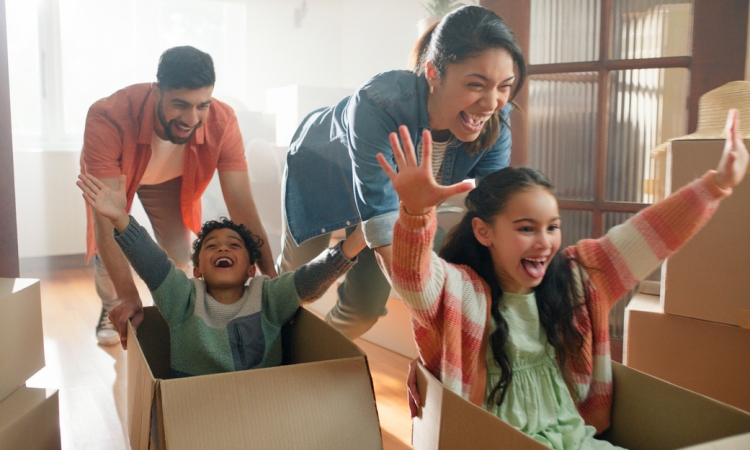Moving long-distance with children mixes excitement with challenges. Whether your interstate move is for a new job, better opportunities, or a fresh start, read on for practical tips to create a stress-free experience for your children and make your family’s transition as smooth as possible. Let’s explore effective strategies to navigate the complexities of moving, transforming potential stress into an adventure for the whole family.
Preparation before a long-distance move
Establishing a detailed timeline for packing and preparations is essential to ensure a smooth move. Begin by determining critical deadlines, such as the final day to pack non-essentials and the day you intend to move larger furniture. This schedule should be as detailed as possible, allocating specific days or weeks for different areas of your home. This structured approach helps distribute the workload evenly, preventing any last-minute rushes that can add extra stress.
We recommend using JK Moving’s moving checklists. These invaluable tools guide you through every necessary step of the packing process. Avoid overlooking important details by checking off tasks as you complete them. This systematic tracking helps maintain order and significantly reduces the anxiety associated with moving. If your relocation involves moving from Virginia to North Carolina, you’ll find that having a checklist tailored to long-distance family moves can make the process even smoother.
Involving the kids
Making a long-distance move inclusive for your children is vital for their adjustment to the change. Involve them by assigning age-appropriate tasks, such as packing their toys or choosing items to donate. This involvement helps lighten your workload and makes the children feel they have a meaningful role in the family’s transition.
Hold regular family meetings to discuss the move. These should be conducted in a positive, open atmosphere where children are encouraged to express their feelings and ask questions. Use simple, reassuring language and focus on the exciting aspects of a cross-country move, such as the new friends they’ll meet or the new places they’ll explore. This approach can help mitigate fears and transform the moving experience into an enjoyable adventure.
to discuss the move. These should be conducted in a positive, open atmosphere where children are encouraged to express their feelings and ask questions. Use simple, reassuring language and focus on the exciting aspects of a cross-country move, such as the new friends they’ll meet or the new places they’ll explore. This approach can help mitigate fears and transform the moving experience into an enjoyable adventure.
Packing strategies
- Label each box clearly with its contents and the room where it should end up. This will aid in the unpacking process and ensure that essential items are easily accessible. For instance, label boxes containing daily necessities with “Open First.”
- Start packing one room at a time to avoid clutter and confusion. This method ensures that similar items stay together, making setting up your new home more systematic and less overwhelming.
Essential items
Each family member should have a personal essentials bag that includes items they’ll need easy access to during the move, such as medications, chargers, snacks, a few changes of clothes, and favorite toys, books, and activities for your kids. This bag will be necessary during the first few nights in your new home when most of your belongings are still packed away.
By incorporating these strategies, you can ensure that your long-distance move is well-organized and less stressful for everyone involved, particularly your children.
Settling into your new home after moving to a new state
The first day in your new home is important for setting a positive tone. Prioritize setting up your children’s rooms to give them a sense of familiarity and security. Personalize their spaces with their favorite bedding, toys, or posters right away. This can reduce their stress and help them feel at home sooner.
Begin exploring your new surroundings by visiting nearby parks, playgrounds, or other family-friendly attractions. These short excursions not only help your family adjust but also create a sense of excitement about the new location.
Starting school and making friends
Starting a new school in an unfamiliar place can be difficult. Prepare your children for their new schools by discussing what to expect and encouraging a positive outlook. Some things you can do to help your kids get off to a great start include:
- Attending back-to-school events
- Establishing routines
- Getting involved at the school
- Signing up for extracurricular activities
For more tips and strategies, read more on starting a new school after moving. This preparation can ease their transition and build confidence in their new environment.
Social integration
Encourage your children to make new friends and participate in local community activities or sports. Attend social gatherings, community events, or parent meetings to connect with other families. Facilitating these connections early on can help your children integrate more smoothly into their new community.
Embracing the journey ahead
Moving long-distance with kids is a journey that requires thoughtful planning, patience, and adaptability. While the process can be challenging, it presents a unique opportunity for your family to grow closer and explore new experiences together. By implementing these cross-country moving tips, you can turn the complexities of moving into a rewarding adventure for everyone involved.
As you settle into your new home, remember that the adjustment period is a time of transition for your children and yourself. Embrace the small victories — whether it’s unpacking the last box or seeing your child make their first new friend — as milestones in your family’s shared experience. By fostering open communication, maintaining familiar routines, and taking the time to explore your new surroundings, you can ease the stress of the move and create lasting, positive memories.


